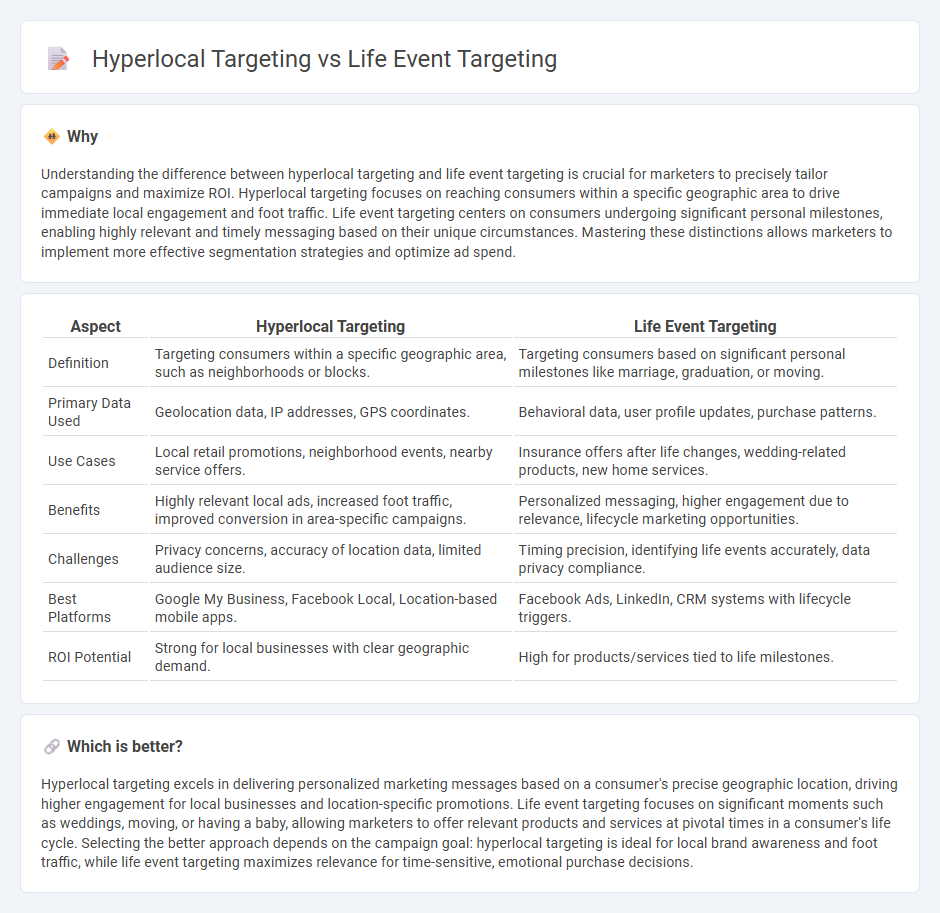
Hyperlocal targeting focuses on reaching consumers within a specific geographic radius, leveraging location data to deliver highly relevant offers and advertisements based on immediate surroundings. Life event targeting, on the other hand, tailors marketing messages to significant personal milestones such as marriage, home buying, or childbirth, capitalizing on the heightened consumer intent during these times. Discover how integrating these strategies can enhance your marketing effectiveness and customer engagement.
Why it is important
Understanding the difference between hyperlocal targeting and life event targeting is crucial for marketers to precisely tailor campaigns and maximize ROI. Hyperlocal targeting focuses on reaching consumers within a specific geographic area to drive immediate local engagement and foot traffic. Life event targeting centers on consumers undergoing significant personal milestones, enabling highly relevant and timely messaging based on their unique circumstances. Mastering these distinctions allows marketers to implement more effective segmentation strategies and optimize ad spend.
Comparison Table
| Aspect | Hyperlocal Targeting | Life Event Targeting |
|---|---|---|
| Definition | Targeting consumers within a specific geographic area, such as neighborhoods or blocks. | Targeting consumers based on significant personal milestones like marriage, graduation, or moving. |
| Primary Data Used | Geolocation data, IP addresses, GPS coordinates. | Behavioral data, user profile updates, purchase patterns. |
| Use Cases | Local retail promotions, neighborhood events, nearby service offers. | Insurance offers after life changes, wedding-related products, new home services. |
| Benefits | Highly relevant local ads, increased foot traffic, improved conversion in area-specific campaigns. | Personalized messaging, higher engagement due to relevance, lifecycle marketing opportunities. |
| Challenges | Privacy concerns, accuracy of location data, limited audience size. | Timing precision, identifying life events accurately, data privacy compliance. |
| Best Platforms | Google My Business, Facebook Local, Location-based mobile apps. | Facebook Ads, LinkedIn, CRM systems with lifecycle triggers. |
| ROI Potential | Strong for local businesses with clear geographic demand. | High for products/services tied to life milestones. |
Which is better?
Hyperlocal targeting excels in delivering personalized marketing messages based on a consumer's precise geographic location, driving higher engagement for local businesses and location-specific promotions. Life event targeting focuses on significant moments such as weddings, moving, or having a baby, allowing marketers to offer relevant products and services at pivotal times in a consumer's life cycle. Selecting the better approach depends on the campaign goal: hyperlocal targeting is ideal for local brand awareness and foot traffic, while life event targeting maximizes relevance for time-sensitive, emotional purchase decisions.
Connection
Hyperlocal targeting leverages precise geographic data to reach customers within specific neighborhoods, while life event targeting focuses on personalized marketing during significant personal milestones such as moving, marriage, or childbirth. Both strategies utilize detailed consumer behavior insights and location-based data to deliver highly relevant and timely advertisements. Combining hyperlocal targeting with life event triggers enhances engagement by addressing immediate needs and preferences in the consumer's local context.
Key Terms
**Life Event Targeting:**
Life event targeting leverages data on significant milestones such as marriage, moving, or having a child to deliver highly relevant advertisements tailored to users' immediate needs and interests. This method enhances campaign effectiveness by aligning product or service offers with specific life transitions, increasing engagement and conversion rates. Explore the benefits of integrating life event targeting into your marketing strategy to maximize ROI and customer connection.
Milestones
Life event targeting zeroes in on significant personal milestones such as weddings, graduations, and new home purchases to deliver tailored marketing messages. Hyperlocal targeting emphasizes reaching consumers based on their specific geographic location, often capturing immediate neighborhood activities and local preferences. Explore how both strategies can be leveraged to maximize engagement around key life moments.
Behavioral Data
Life event targeting leverages behavioral data to identify significant personal milestones such as marriages, graduations, or relocations, enabling precise ad delivery aligned with consumer needs during these transitions. Hyperlocal targeting uses behavioral data to focus on user activities within specific geographic areas to deliver contextually relevant ads based on location-specific patterns and preferences. Explore more to understand how integrating life event and hyperlocal behavioral data enhances the effectiveness of targeted marketing campaigns.
Source and External Links
Understanding Google Ads Life Events Audience Targeting - Life event targeting in Google Ads allows advertisers to reach users undergoing major life changes such as moving, marriage, graduation, or retirement, which often trigger new purchasing behaviors, enabling highly relevant and timely ad campaigns during a six-month window around these events.
The Benefits of Life Events Targeting in Google Ads - Life event targeting can significantly boost marketing effectiveness by focusing on consumers during key milestones like recent movers or newly married users, as shown in case studies where targeting these groups resulted in substantial increases in purchase intent and brand search.
Life Event Marketing to Target Consumers - Life event marketing is a strategic approach focused on delivering marketing messages at critical life moments when consumers are more receptive, such as marriage, buying a home, or having a baby, leveraging data insights to meet consumer needs with high relevance.
 dowidth.com
dowidth.com